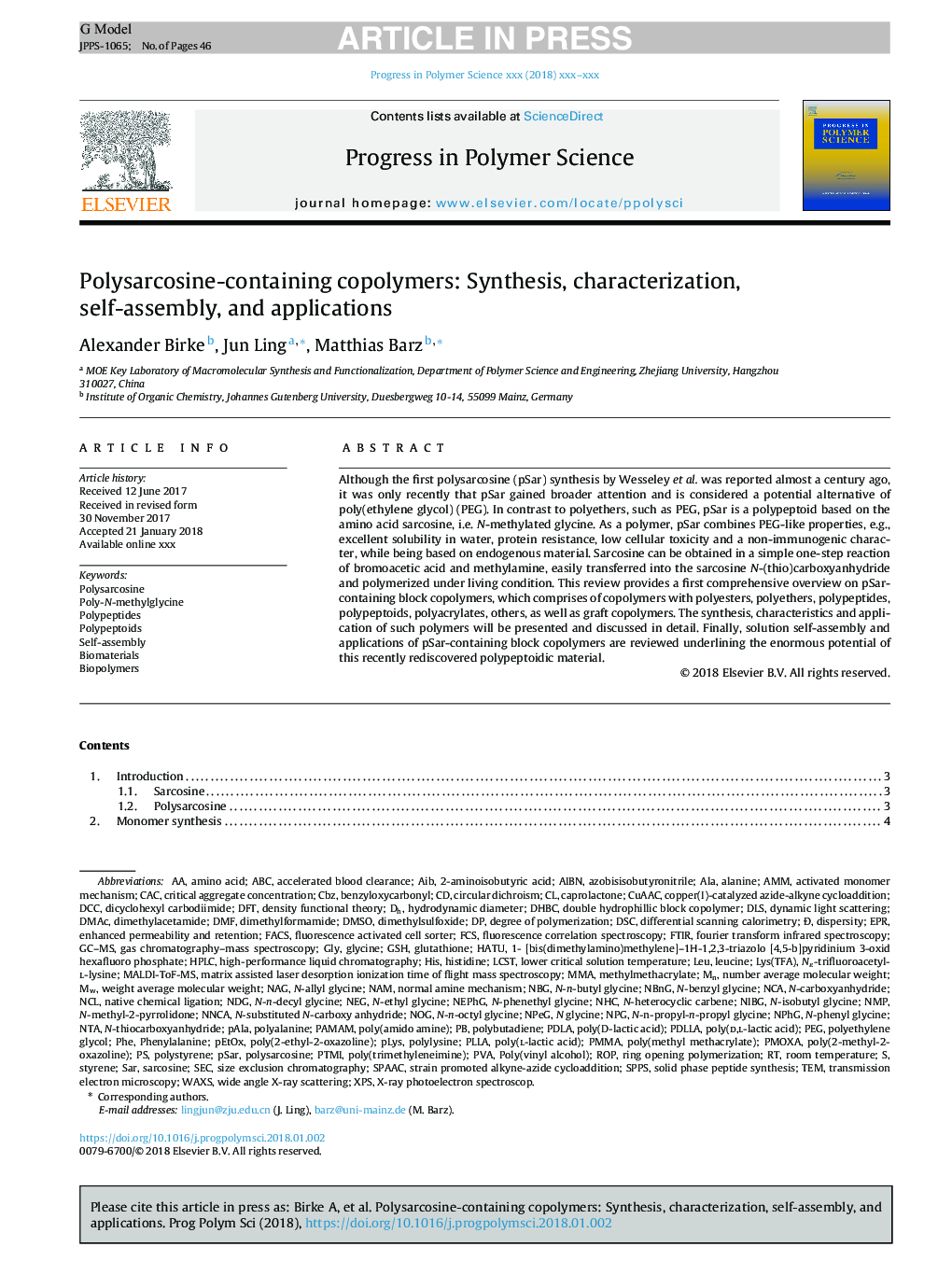| Article ID | Journal | Published Year | Pages | File Type |
|---|---|---|---|---|
| 7825777 | Progress in Polymer Science | 2018 | 46 Pages |
Abstract
Although the first polysarcosine (pSar) synthesis by Wesseley et al. was reported almost a century ago, it was only recently that pSar gained broader attention and is considered a potential alternative of poly(ethylene glycol) (PEG). In contrast to polyethers, such as PEG, pSar is a polypeptoid based on the amino acid sarcosine, i.e. N-methylated glycine. As a polymer, pSar combines PEG-like properties, e.g., excellent solubility in water, protein resistance, low cellular toxicity and a non-immunogenic character, while being based on endogenous material. Sarcosine can be obtained in a simple one-step reaction of bromoacetic acid and methylamine, easily transferred into the sarcosine N-(thio)carboxyanhydride and polymerized under living condition. This review provides a first comprehensive overview on pSar-containing block copolymers, which comprises of copolymers with polyesters, polyethers, polypeptides, polypeptoids, polyacrylates, others, as well as graft copolymers. The synthesis, characteristics and application of such polymers will be presented and discussed in detail. Finally, solution self-assembly and applications of pSar-containing block copolymers are reviewed underlining the enormous potential of this recently rediscovered polypeptoidic material.
Keywords
ABCDSCDLSDMFFACSdimethylacetamideCACCbzNTANHCGSHPHEALALEUMMAFCSDCCNAGNCLPLLAPDLLANCANMPDMACAIBNAMMLcstPDLApoly(D-lactic acid)CuAACAzobisisobutyronitrileN-methyl-2-pyrrolidonePTMINPGCopper(I)-catalyzed azide-alkyne cycloadditionDHBCNDGdicyclohexyl carbodiimidePLysNBGDFTDMSOGC–MSN-heterocyclic carbenealanineamino acid2-Aminoisobutyric acidNOGbenzyloxycarbonylaccelerated blood clearanceEPRHISdegree of polymerizationLower critical solution temperaturedimethylformamideDimethylsulfoxidecircular dichroismAibFTIRgas chromatography–mass spectroscopyFourier transform infrared spectroscopyfluorescence correlation spectroscopyCritical aggregate concentrationfluorescence activated cell sorterPhenylalaninehydrodynamic diameterLeucineMALDI-TOF-MSMethylmethacrylateactivated monomer mechanismNAMDensity functional theoryEnhanced permeability and retentionnegN-carboxyanhydrideHATUhistidineWeight average molecular weightNumber average molecular weightPALAPAMAMDispersityDynamic Light ScatteringPoly(2-ethyl-2-oxazoline)Poly(2-methyl-2-oxazoline)poly(d,l-lactic acid)Poly(L-lactic acid)Poly(methyl methacrylate)PMMAPolyalaninePoly(amido amine)polyethylene glycolPolybutadienePolylysinePEGPolystyreneNative chemical ligationDifferential scanning calorimetryCaprolactoneHPLChigh-performance liquid chromatographyGlutathioneGlyGlycine
Related Topics
Physical Sciences and Engineering
Chemistry
Organic Chemistry
Authors
Alexander Birke, Jun Ling, Matthias Barz,
